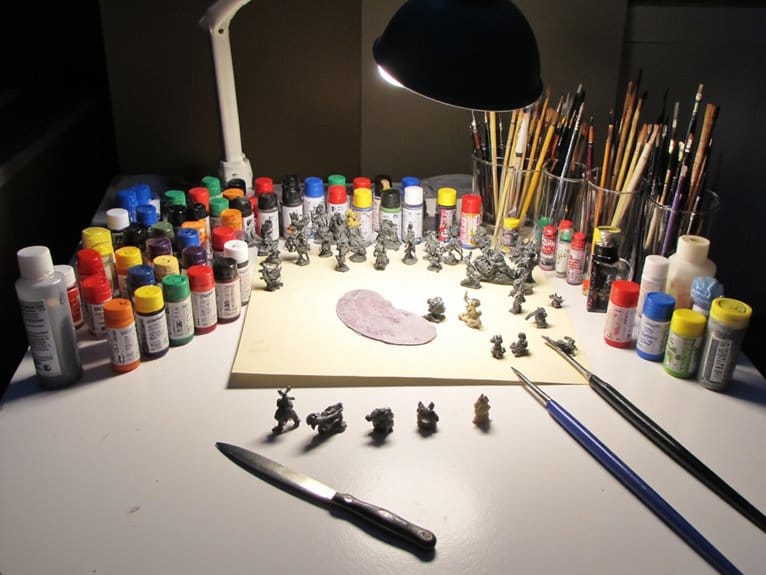We are supported by our audience. When you purchase through links on our site, we may earn an affiliate commission, at no extra cost for you. Learn more. Last update on 10th July 2025 / Images from Amazon Product Advertising API.
Are you a die-hard fan of painting miniatures? Are you ready to level up your painting game? Well, my friend, let's talk about the magical world of color primers.
Trust me, choosing the right primer is like finding the perfect ingredient for a delectable dish. It's the secret sauce that can transform your miniatures into jaw-dropping masterpieces. So, buckle up and let's dive into the wonderful world of primers!
Now, you might wonder, 'Why on earth do I need a primer?' Well, my friend, let me tell you a little secret. Primers are like the foundation of a building. They create a smooth canvas for your paints, ensuring that they adhere flawlessly and deliver vibrant, long-lasting results. Without a primer, your precious paint job might end up looking patchy and lackluster. And nobody wants that, right?
But here's the exciting part – there are different types of primers out there, just waiting for you to explore! You've got your classic white primer, which is like a clean slate, ready to showcase your colors in all their glory. Then there's the black primer, which adds depth and drama, perfect for those moody, mysterious vibes. And let's not forget about the colored primers, my friend. These little gems not only provide a solid base, but they also double up as your base coat. It's like getting two birds with one stone!
Imagine this – you're a painter, standing in front of a blank canvas. You dip your brush into the primer, and with each stroke, you're building a strong foundation for your artwork. The primer fills in the gaps, creating a seamless surface for your paints to dance upon. It's like giving your miniatures a solid armor, protecting them from the wear and tear of time.
And here's the cherry on top, my friend. Using colored primers saves you precious time. No more slaving away with multiple layers of primer and base coat. With a colored primer, you can combine the two in one swift move. It's like having a superhero sidekick that streamlines your painting process, allowing you to focus on the fun part – adding those intricate details and bringing your miniatures to life.
So, my fellow miniature painting enthusiast, the choice is yours. Which color primer will you choose to embark on your painting journey? Will you go for the classic white, the mysterious black, or the time-saving colored primer? Whatever you decide, just remember that primers are the unsung heroes of the painting world, ready to elevate your craft to new heights. Happy painting, my friend!
Key Takeaways
- Priming is necessary for all models except pre-primed ones
- Tailor the choice of primer to the specific project
- Colored primers save a step in the painting process
- Different colored primers have specific uses and benefits
Importance of Primers
To understand the importance of primers in miniature painting, you need to know that they create a protective layer between the model and paint. Primers have several advantages that contribute to the overall quality of the finished piece. They provide a smooth surface for the paint to adhere to, ensuring better coverage and reducing the chances of chipping or peeling. Additionally, primers help to create a uniform base color, enhancing the vibrancy and accuracy of the final paint job.
To properly apply primers, it's essential to follow a few key steps. First, make sure the model is clean and free of any dust or debris. Next, shake the primer can thoroughly to ensure an even distribution of pigment. Hold the can about 6-8 inches away from the model and spray in short, controlled bursts, moving the can in a sweeping motion to cover the entire surface. Allow the primer to dry completely before proceeding with the painting process.
Traditional Primer Colors
When choosing a traditional primer color for your miniature painting project, consider the options of black, white, and grey.
Each color has its own advantages and can greatly affect the final appearance of your model.
Black primer is commonly used for darker and grittier themes, as it provides a solid base for darker shades and enhances shadows.
White primer, on the other hand, is ideal for achieving bright and vibrant colors, as it provides a stark contrast and allows the colors to pop.
Grey primer is a versatile choice that works well with a variety of color schemes, providing a neutral base for both light and dark shades.
Experimenting with different primer colors can help you achieve the desired effect for your miniature painting project.
Alternative Primers
Consider exploring alternative primers for your miniature painting projects to broaden your options and achieve different effects. By experimenting with different primers, you can discover new techniques and enhance the overall look of your models. While traditional primer colors like black, white, and grey are widely used, there are alternative options available that can add uniqueness to your projects. Here are some alternative primer options you can consider:
| Primer Type | Recommended Brands |
|---|---|
| Colored Primers | Vallejo, Steindl Res |
| Automotive Primers | Krylon, Red Oxide Sandable Auto Primer |
| Primer and Base Coat Combination | Army Painter |
These alternative primers can be found in auto stores, hardware stores, or online. They offer different properties and finishes, allowing you to achieve various effects and cater to specific project requirements. Remember to research and test different brands and types of primers to find the right one for your project. The key is to embrace innovation and explore the vast world of alternative primers.
Benefits of Colored Primers
Using colored primers in your miniature painting projects offers a range of benefits that can enhance the overall appearance and efficiency of your painting process.
One of the advantages of colored primers is that they can save you a step in the painting process. Model companies offer colored primers that can serve as both a primer and a base coat, eliminating the need to apply a separate base coat. This can save you time and effort, allowing you to focus on the finer details of your painting.
Additionally, colored primers are available for both rattle cans and airbrushing, giving you flexibility in choosing the application method that works best for you.
However, it's important to note that colored primers may have limitations in terms of color options. While there are a variety of colored primers available, they may not cover the entire spectrum of colors that you may want to use in your painting projects.
It's important to consider the limitations of colored primers and choose the right one for your specific project.
Specific Uses of Colored Primers
Colored primers offer specific advantages in your miniature painting projects, allowing you to achieve desired effects and enhance the overall appearance of your models. When it comes to specific uses of colored primers, there are several options to consider:
- Using colored primers for weathering effects: Certain colored primers, such as rust or dirt tones, can be used to create realistic weathering effects on your models. These primers provide a base layer that adds depth and texture to your paint job.
- Experimenting with different brands of colored primers: Each brand may offer a unique range of colors and qualities in their primers. By experimenting with different brands, you can find the ones that best suit your needs and achieve the desired results in your painting projects.
- Customizing primer colors for specific models: Some models, like Necrons or Imperial Knights, may benefit from specific primer colors. Tan or bone colored primers can provide a suitable base for these models, enhancing their appearance and making the painting process more efficient.
- Using lighter or darker primers for different effects: Lighter primers like white can help achieve bright and vibrant colors, while darker primers create a darker and grittier appearance. By planning ahead and investing in quality primers, you can save time and effort in the painting process while achieving the desired effects.
Can the Color of Primer Affect the Choice of Varnish for Miniature Painting?
When choosing types of varnish for miniature painting, it’s important to consider the color of primer used. Light-colored primers work best with lighter varnishes, while darker primers are better suited for darker varnishes. The color of primer can significantly affect the final appearance of the miniature painting.
Frequently Asked Questions
Can I Use Any Type of Paint as a Primer for My Miniatures?
No, not any type of paint can be used as a primer for miniatures. Different types of primers have specific advantages and disadvantages. Using the right primer ensures better paint adhesion and overall quality of the finished miniature.
How Long Does It Typically Take for a Primer to Dry Before I Can Start Painting?
It typically takes a primer a few hours to dry completely before you can start painting. Using a primer before painting miniatures has benefits like better paint adhesion, smoother finish, and increased durability.
Are There Any Specific Primers Recommended for Painting Plastic Miniatures?
When painting plastic miniatures, it is important to use the best primers for metal miniatures. To achieve a smooth primer application, try techniques like thinning the primer and using multiple light coats.
Can I Use Colored Primers on Top of Each Other to Create Different Effects?
Yes, you can experiment with layering different colored primers to create shading and highlighting effects. This technique allows for unique color combinations and adds depth to your miniatures.
Are There Any Primers Specifically Designed for Use With Airbrushes?
Yes, there are alternative primers specifically designed for airbrushing. You can mix different primers to create a unique effect, allowing for experimentation and innovation in your painting process.
Conclusion
In conclusion, selecting the right color primer is crucial for achieving stunning results in miniature painting. Primers play a vital role in creating a smooth layer between the model and the paint, ensuring better coverage and adhesion.
Considering factors such as the project theme or color scheme can help guide your choice of primer. Colored primers offer the added benefit of saving time by combining the primer and base coat in one step.
So, choose your color primer wisely and enhance your miniature creations.





